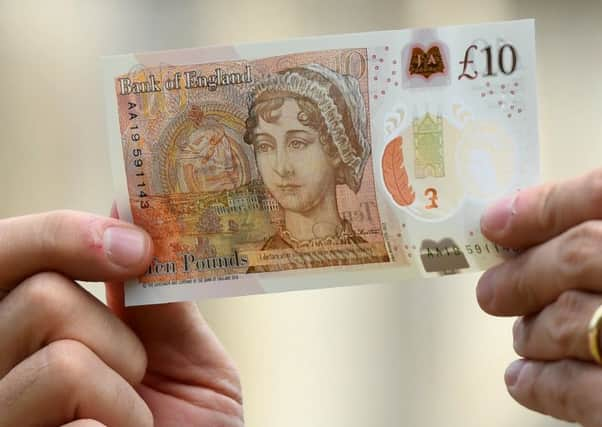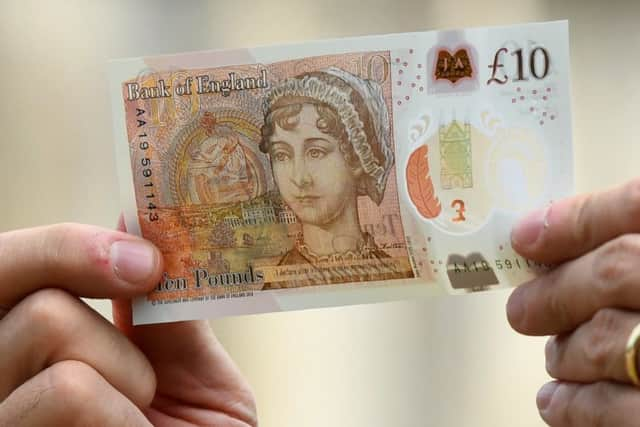New £10 Jane Austen banknote goes into circulation


The new tenner is the first Bank of England banknote with a tactile feature to help blind and partially-sighted users.
The new tactile feature is a series of raised dots in the top left-hand corner of the banknote, developed with the help of the RNIB.
Advertisement
Hide AdAdvertisement
Hide AdLike the £5 note already in circulation featuring Sir Winston Churchill, the new £10 banknote featuring Pride And Prejudice author Austen is made from polymer.


Just over one billion polymer £10 notes have been printed ready for issue and they will start to appear in wallets as the notes leave cash centres around the country and enter general circulation.
The new banknotes are expected to last at least two-and-a-half times longer than the current paper £10 notes, around five years in total, and stay in better condition during day-to-day use.
People can continue to spend the existing paper £10 notes for now. They will be phased out gradually as they are banked.
Legal tender status of the paper £10 featuring Charles Darwin will eventually be withdrawn in spring 2018.


The exact date will be announced at least three months in advance.
A new £20 note featuring artist JMW Turner will follow in 2020.
• READ MORE: Are Scottish banknotes the most forged in the UK?
Advertisement
Hide AdAdvertisement
Hide AdThe transition to polymer has sparked controversy after the Bank confirmed that an “extremely small amount” of tallow, or animal fat, was used to produce polymer pellets, which were part of the production process for creating the notes.
In August, following a public consultation, the Bank said that after “careful and serious consideration”, there would be no change to the composition of polymer used for future banknotes.
It said the only viable alternative was palm oil, but this raised questions about environmental sustainability and value for money.
Bank of England governor Mark Carney said: “The new £10 note celebrates Jane Austen’s work. Austen’s novels have a universal appeal and speak as powerfully today as they did when they were first published.
“The new £10 will be printed on polymer, making it safer, stronger and cleaner.
“The note will also include a new tactile feature on the £10 to help the visually impaired, ensuring the nation’s money is as inclusive as possible.”
This year has marked 200 years since Austen’s death.
Born on December 16 1775, in Steventon, Hampshire, Austen was one of eight siblings.
She started to write short, comic stories in childhood, and her first works were published anonymously.
Advertisement
Hide AdAdvertisement
Hide AdSense And Sensibility was published in 1811, followed by Pride And Prejudice in 1813, originally titled First Impressions. Mansfield Park, Emma, Persuasion and Northanger Abbey followed.
While her work gave her little personal fame during her lifetime, Austen’s novels started appearing on university reading lists around the start of the 20th century, with many films later exploring the themes of her writing.
Austen died on July 18 1817.
Victoria Cleland, the Bank’s chief cashier, said: “It is wonderful to see the inspirational author Jane Austen celebrated on the new £10, and even more poignant being launched during the 200th anniversary of her death. I am grateful to the cash industry for their support in bringing the cleaner, safer, stronger notes to the public.”